James Joyce作品简介
- 格式:ppt
- 大小:8.54 MB
- 文档页数:12


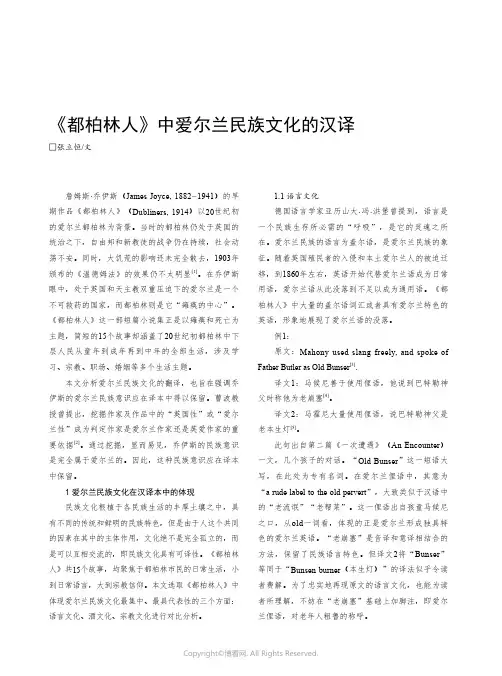
| 中外互鉴《都柏林人》中爱尔兰民族文化的汉译□张立恒/文詹姆斯·乔伊斯(James Joyce, 1882-1941)的早期作品《都柏林人》(Dubliners, 1914)以20世纪初的爱尔兰都柏林为背景。
当时的都柏林仍处于英国的统治之下,自由邦和新教徒的战争仍在持续,社会动荡不安。
同时,大饥荒的影响还未完全散去,1903年颁布的《温德姆法》的效果仍不太明显[1]。
在乔伊斯眼中,处于英国和天主教双重压迫下的爱尔兰是一个不可救药的国家,而都柏林则是它“瘫痪的中心”。
《都柏林人》这一部短篇小说集正是以瘫痪和死亡为主题,简短的15个故事却涵盖了20世纪初都柏林中下层人民从童年到成年再到中年的全部生活,涉及学习、宗教、职场、婚姻等多个生活主题。
本文分析爱尔兰民族文化的翻译,也旨在强调乔伊斯的爱尔兰民族意识应在译本中得以保留。
曹波教授曾提出,挖掘作家及作品中的“英国性”或“爱尔兰性”成为判定作家是爱尔兰作家还是英爱作家的重要依据[2]。
通过挖掘,显而易见,乔伊斯的民族意识是完全属于爱尔兰的。
因此,这种民族意识应在译本中保留。
1 爱尔兰民族文化在汉译本中的体现民族文化根植于各民族生活的丰厚土壤之中,具有不同的传统和鲜明的民族特色,但是由于人这个共同的因素在其中的主体作用,文化绝不是完全孤立的,而是可以互相交流的,即民族文化具有可译性。
《都柏林人》共15个故事,均聚焦于都柏林市民的日常生活,小到日常语言,大到宗教信仰。
本文选取《都柏林人》中体现爱尔兰民族文化最集中、最具代表性的三个方面:语言文化、酒文化、宗教文化进行对比分析。
1.1 语言文化德国语言学家亚历山大·冯·洪堡曾提到,语言是一个民族生存所必需的“呼吸”,是它的灵魂之所在。
爱尔兰民族的语言为盖尔语,是爱尔兰民族的象征。
随着英国殖民者的入侵和本土爱尔兰人的被迫迁移,到1860年左右,英语开始代替爱尔兰语成为日常用语,爱尔兰语从此没落到不足以成为通用语。
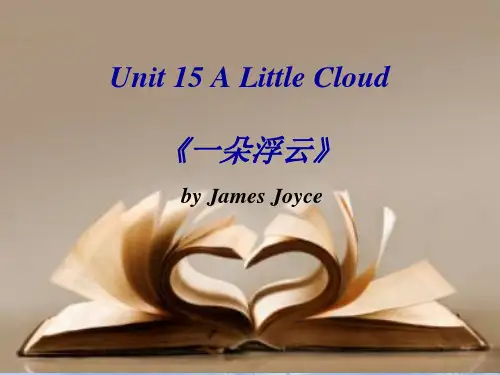

"Araby"Backgrounds IntroductionIreland's major religion, Roman Catholicism, dominated Irish culture, as it continues to do today although to a lesser extent. Many families sent their children to schools run by Jesuit priests (like the one the narrator in attends) and convent schools run by nuns (like the one Mangan's sister attends). Catholicism is often seen as a source of the frequent conflict in Irish culture between sensuality and asceticism, a conflict that figures prominently in Joyce's autobiographical novel A Portrait of the Artist as a Young Man . In many ways, Catholicism, particularly as practiced at the turn of the century, was an extremely sensuous religion, emphasizing intense personal spiritual experience and surrounding itself with such rich trappings as beautiful churches, elegant paintings and statues, otherworldly music, and sumptuous vestments and altar decorations. On the other hand, the Church's official attitude toward enjoyment of the senses and particularly toward sexuality was severe and restrictive. The ideal woman was the Virgin Mary, who miraculously combined virginal purity with maternity. Motherhood was exalted, but any enjoyment of sexuality, even in marriage, was considered a sin, as were the practice of birth control and abortion. The inability to reconcile the spiritual and sensual aspects of human nature can be seen in the boy's feelings toward Mangan's sister in He imagines his feelings for her as a "chalice"--a sacred religious object--and so worshipful is his attitude that he hesitates even to speak to her. Yet his memories of her focus almost exclusively on her body--her figure silhouetted by the light, the "soft rope of her hair," "the white curve of her neck," the border of her petticoat. Even the image of the chalice is ambivalent, since its cup-like shape and function suggests a sexual connotation. The boy never resolves this conflict between spirituality and sensuality. Instead, when confronted with the tawdriness of a shopgirl's flirtation at the bazaar, he abruptly dismisses all his feelings as mere "vanity."Introduction of the story and the author"Araby" is one of fifteen short stories that together make up James Joyce's collection, Dubliners.Although Joyce wrote the stories between 1904 and 1906, they were not published until 1914.Dubliners paints a portrait of life in Dublin, Ireland, at the turn of the 20th century. Its stories are arranged in an order reflecting the development of a child into a grown man. The first three stories are told from the point of view of a young boy, the next three from the point of view of an adolescent, and so on."Araby" is the last story of the first set, and is told from the perspective of a boy just on the verge of adolescence. The story takes its title from a real festival which came to Dublin in 1894 when Joyce was twelve years old.Joyce is one of the most famous writers of the Modernist period of literature, which runs roughly from 1900 to the end of World War II. Modernist works often include characters who are spiritually lost and themes that reflect a cynicism toward institutions the writer had been taught to respect, such as government and religion. Much of the literature of this period is experimental; Joyce's writing reflects this in the use of dashes instead of quotation marks to indicate that a character is speaking.Joyce had a very difficult time getting Dubliners published. It took him over ten years to find a publisher who was willing to risk publishing the stories because of their unconventional style and themes. Once he found a publisher, he fought very hard with the editors to keep the stories the way he had written them. Years later, these stories are heralded not only for their portrayal of life in Dublin at the turn of the century, but also as the beginning of the career of one of the most brilliant English-language writers of the twentieth century.Plot"Araby" opens on North Richmond street in Dublin, where "an uninhabited house of two storeys stood at the blind end, detached from its neighbours in a square ground." The narrator, who remains unnamed throughout the story, lives with his aunt and uncle. He describes his block, then discusses the former tenant who lived in his house: a priest who recently died in the back room. This priest has a library that attracts the young narrator, and he is particularly interested in three titles: a Sir Walter Scott romance, a religious tract, and a police agent's memoirs.The narrator talks about being a part of the group of boys who play in the street. He then introduces Mangan's sister, a girl who captivates his imagination even though he rarely, if ever, speaks with her. He does stare at her from his window and follow her on the street, however, often thinking of her "even in places the most hostile to romance." While in the marketplace on Saturday nights, for example, he uses her image to guide him through the thronging crowd who yell their sales pitches and sing patriotic Irish ballads. He becomes misty-eyed just at the thought of her and retreats to the priest's dark room in order to deprive himself of other senses and think only of her.Finally, Mangan's sister speaks to him. She asks if he will be attending a church-sponsored fair that is coming soon to Dublin--a bazaar called "Araby." He is tongue-tied and cannot answer, but when she tells him that she cannot go because of a retreat that week in her convent, he promises to go and bring her a gift from the bazaar. From then on he can only think of the time when he will be at the fair; he is haunted by "the syllables of the word Araby." On the night he is supposed to attend the fair, his uncle is late returning home and he must wait to get money from him. He gets very anxious, and his aunt tells him that he may have to miss the bazaar, but his uncle does come home, apologetic that he had forgotten. After asking the boy if he knows a poem entitled "The Arab's Farewell to His Steed," the uncle bids the boy farewell.The boy takes a coin from his uncle and catches a train to the fair. Araby is closing down as he arrives and he timidly walks through the center of the bazaar. As he looks at the few stalls that are still open, he overhears a conversation between an English shop-girl and two young men. Their talk is nothing but idle gossip. The shop-girl pauses reluctantly to ask the boy if he wishes to buy anything, but he declines. As he walks slowly out of the hall amid the darkening of the lights, he thinks that he is a "creature driven and derided by vanity" and his "eyes burned with anguish and anger."CharactersNarrator: The narrator of this story is a young, sensitive boy who confuses a romantic crush and religious enthusiasm. All of the conflict in this story happens inside his mind. It is unlikely that the object of his crush, Mangan's sister, is aware of his feelings for her, nor is anybody else in this boy's small world. Because the boy's thoughts only reveal a part of the story, a careful reader must put together clues that the author gives. For example, the narrator mentions that the former tenant of the house he shares with his aunt and uncle was a priest, a representative of the Catholic church, who left behind three books which became important to the narrator. One is a romantic adventure by Sir Walter Scott; one is a religious pamphlet written by a Protestant; and the third is the exciting memoirs of a French policeman and master of disguise. These three books are not what a person would expect a Catholic priest to have in his library. So if this priest has non-religious literature in his library, then how devout can an average church-goer be expected to be? This turns out to be the case for the narrator, who confuses religious idealism with romance.The boy confuses the religious and secular worlds when he describes himself at the market with his aunt. He bears the chalice--the Communion cup--through a "throng of foes." He also describes Mangan's sister in terms often associated with the Virgin Mary. For the narrator, then, an ordinary grocery-shopping trip becomes a religious crusade, and a pretty girl down the street becomes a substitute for the Mother of God. The boy fuses together religious devotion for the Virgin Mary with his own romantic longing.Joyce is famous for creating characters who undergo an epiphany--a sudden moment of insight--and the narrator of "Araby" is one of his best examples. At the end of the story, the boy overhears a trite conversation between an English girl working at the bazaar and two young men, and he suddenly realizes that he has been confusing things. It dawns on him that the bazaar, which he thought would be so exotic and exciting, is really only a commercialized place to buy things. Furthermore, he now realizes that Mangan's sister is just a girl who will not care whether he fulfills his promise to buy her something at the bazaar.His conversation with Mangan's sister, during which he promised he would buy her something, was really only small talk--as meaningless as the one between the English girl and her companions. He leaves Araby feeling ashamed and upset. This epiphany signals a change in the narrator--from an innocent, idealistic boy to an adolescent dealing with harsh realities.Mangan's Sister: Mangan is one of the narrator's chums who lives down the street. His older sister becomes the object of the narrator's schoolboy crush. Mangan's sister has no idea how the narrator feels about her, however, so when they discuss "Araby," the bazaar coming to town, she is only being polite and friendly. She says she would like to go to the bazaar but cannot because she has to attend a school retreat that weekend. The narrator promises to buy her something at the bazaar if he goes, but it is unlikely that she takes this promise seriously. While on the one hand the narrator describes her romantically, he also describes her in reverential terms which call to mind the Virgin Mary. This dual image description of Mangan's sister represents the religious and romantic confusion of the narrator.Mangan: Mangan is the same age and in the same class at the Christian Brothers school as the narrator, and so he and the narrator often play together after school. His older sister is the object of the narrator's confused feelings.Narrator's Aunt: The narrator's aunt, who is a mother figure in the story, takes the narrator with her to do the marketing. When it seems as though the uncle has forgotten his promise to the narrator that he could go tothe bazaar, she warns the boy that he may have to "put off" the bazaar "for this night of Our Lord." While this statement makes her seem strict in a religious sense, she also exhibits empathy for the boy's plight. She pleads his case when the uncle forgets about the boy's plans to go to Araby.Narrator's Uncle: The narrator's uncle seems self-centered and very unreliable. When the narrator reminds him that he wants to go to the bazaar, he replies, "Yes, boy, I know." But on the Saturday evening of the bazaar, he has forgotten, which causes the narrator to arrive at the bazaar very late. When the uncle finally shows up, he has been drinking, and as the boy leaves for the bazaar he begins reciting the opening lines of the poem, "The Arab's Farewell to his Steed." Joyce's characterization of the uncle bears resemblance to his own father, who liked to drink and was often in debt. Joyce's inclusion of Mrs. Mercer, the pawnbroker's widow who waits for the uncle to return, suggests tha t the uncle owes money.ThemesThe narrator recalls a boyhood crush he had on the sister of a friend. He went to "Araby," a bazaar with an exotic Oriental theme, in order to buy a souvenir for the object of his crush. He arrived late, however, and when he overheard a shallow conversation between a female clerk and her male friends and saw the bazaar closing down, he was overcome with a sense of futility.Alienation and LonelinessThe theme of isolation is introduced early in the story by the image of a deserted, isolated house and the narrator's recollection of a priest who lived and died in their back room. The young protagonist seems isolated within his family. There is no mention of his parents; he lives with his aunt and uncle, and the uncle, in particular, appears insensitive to the boy's feelings, coming home late even though he knows the boy wants to go to the bazaar. The boy's crush on his friend Mangan's sister seems to isolate him even further. He is too tongue-tied to initiate a relationship with her, worshipping her from afar instead. Moreover, his crush appears to isolate him from his friends. Whereas early in the story he is depicted as part of a group of friends playing in the street, after his crush develops his separation from the others is emphasized: he stands by the railings to be close to the girl while the other boys engage in horseplay, and as he waits in the house for his uncle to return so he can go to the bazaar the noises from his friends playing in the street sound "weakened and indistinct." The story ends with him confronting his disillusionment alone in the nearly deserted bazaar.Change and TransformationThe narrator experiences an emotional transformation--changing from an innocent young boy to a disillusioned adolescent--in the flash of an instant, although the reader can look back through the story and trace the forces that lead to the transformation. This change occurs through what Joyce called an "epiphany," a moment of sudden and intense insight. Although the narrator suddenly understands that his romantic fantasies are hopelessly at odds with the reality of his life, this understanding leaves him neither happy nor satisfied; instead, he feels "anguish and anger." It is not clear what impact the narrator's epiphany will have on his future development, only that that development has begun.Fantasy and RealityThe story draws connections between the romantic idealism of the young protagonist's attitude toward Mangan's sister and romantic fantasies in the surrounding culture. Much of this romanticism seems to stem from religion, the pervasive presence of which is emphasized by mentions of the youngsters' parochial schools, repeated references to the dead priest, and the aunt 's fear that the bazaar might be a "Freemason" affair and her reference to "[T]his night of our Lord." The boy carries his thoughts of Mangan's sister like a "chalice through a throng of foes," and his crush inspires in him "strange prayers and praises." The way the girl herself is described--as an alluring but untouchable figure dramatically lit--and the boy's worshipful attitude give her something of the character of a religious statue. Popular culture is also suggested as a source of the boy's romanticism, in the references to Sir Walter Scott's The Abbot and the poem "The Arab's Farewell to His Steed." The contrast between fantasy and reality draws to a head at the Araby bazaar, whose exotic name is merely packaging for a crassly commercial venture. In the nearly deserted hall and the insipid flirtation he overhears between two men and a shopgirl, the protagonist is confronted with huge gap between his romantic fantasies of love and the mundane and materialistic realities of his life.ConstructionThrough the use of a first person narrative, an older narrator recalls the confused thoughts and dreams of his adolescent self. Joyce uses this familiarity with the narrator 's feelings to evoke in readers a response similar to the boy's "epiphany"--a sudden moment of insight and understanding--at the turning point of the story.Point of Viewis told from the first person point of view, but its perspective is complicated by the gap in age and perception between the older narrator and the younger self he remembers. The story takes the form of a reminiscence about an apparent turning point in the narrator 's growth, a partial explanation of how the young protagonist became the older self who is the narrator. The reader is given no direct information about the narrator, however, his relentless contrasting of his boyhood self's idealism with the tawdry details of his life, and the story 's closing line, create a somewhat bitter and disillusioned tone. It is left to the reader to decide how far the narrator has travelled toward a "true" understanding of reality.SymbolismJoyce's use of symbolism enriches the story 's meaning. The former tenant of the narrator's house, the Catholic priest, could be said to represent the entire Catholic church. By extension, the books left in hisroom--which include non-religious and non-Catholic reading--suggest a feeling of ambiguity toward religion in general and Catholicism in particular. The bazaar "Araby" represents the "East"--a part of the world that is exotic and mysterious to the Irish boy. It could also represent commercialism, since despite the boy's romantic imaginings its purpose is in fact to make money. Mrs. Mercer, the pawnbroker's widow, is another representative of materialism. To the narrator, Mangan's sister is a symbol of purity and feminine perfection. These qualities are often associated with the Virgin Mary, who also symbolizes the Catholic church. While the boy is at Araby, the various, and often contrasting, meanings of these symbols converge to produce his epiphany.ModernismJoyce is known as one of the leading authors of Modernism, a movement in art and literature in the first half of the twentieth century that emphasized experimentation and a break with traditional forms. In this early work Joyce's narrative technique is still fairly traditional and straightforward. However, several features of the story can be identified as experimental and modernist, particularly in the extent to which the reader is left to sort out the story 's meaning with little overt help from the author. The story concerns a relatively ordinary occurrence in the life of an ordinary person; we are never told directly how or why it might be important. We are given no direct information about the narrator, but must glean what we can about his character from the story he tells and the way in which he tells it; we are not even told what the age difference is between the narrator and his younger self. The story ends, as it begins, abruptly, with again no direct indication of thesignificance of the protagonist's "epiphany," his older self's attitude toward it, or what it meant for his further development. Much of the early criticism of -that the stories were "sordid" and lacked structure and a "point"--reflect the unfamiliarity and uneasiness of Joyce's contemporary readers with these innovations in storytelling.。
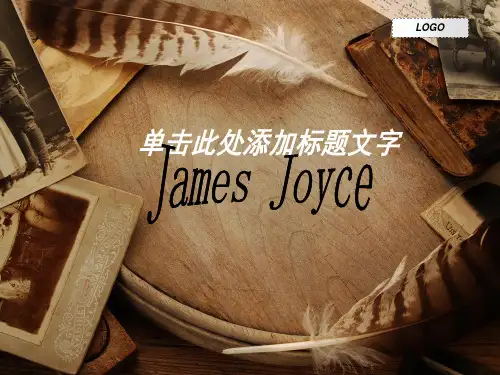
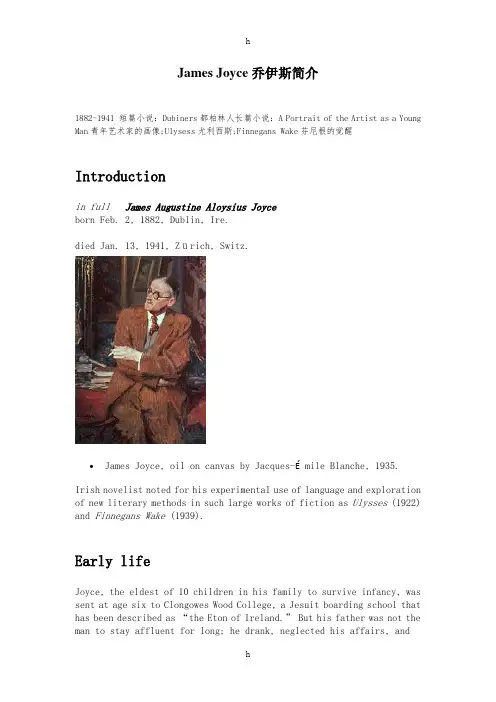
James Joyce乔伊斯简介1882-1941 短篇小说:Dubiners都柏林人长篇小说:A Portrait of the Artist as a Young Man青年艺术家的画像;Ulysess尤利西斯;Finnegans Wake芬尼根的觉醒Introductionin full James Augustine Aloysius Joyceborn Feb. 2, 1882, Dublin, Ire.died Jan. 13, 1941, Zürich, Switz.•James Joyce, oil on canvas by Jacques-Émile Blanche, 1935.Irish novelist noted for his experimental use of language and exploration of new literary methods in such large works of fiction as Ulysses(1922) and Finnegans Wake (1939).Early lifeJoyce, the eldest of 10 children in his family to survive infancy, was sent at age six to Clongowes Wood College, a Jesuit boarding school that has been described as “the Eton of Ireland.” But his father was not the man to stay affluent for long; he drank, neglected his affairs, andborrowed money from his office, and his family sank deeper and deeper into poverty, the children becoming accustomed to conditions of increasing sordidness. Joyce did not return to Clongowes in 1891; instead he stayed at home for the next two years and tried to educate himself, asking his mother to check his work. In April 1893 he and his brother Stanislaus were admitted, without fees, toBelvedere College, a Jesuit grammar school in Dublin. Joyce did well there academically and was twice elected president of the Marian Society, a position virtually that of head boy. He left, however, under a cloud, as it was thought (correctly) that he had lost his Roman Catholic faith.He entered University College, Dublin, which was then staffed by Jesuit priests. There he studied languages and reserved his energies for extracurricular activities, reading widely—particularly in books not recommended by the Jesuits—and taking an active part in the college's Literary and Historical Society. Greatly admiring Henrik Ibsen, he learned Dano-Norwegian to read the original and had an article, Ibsen's New Drama—a review of the play When We Dead Awaken—published in the London Fortnightly Review in 1900 just after his 18th birthday. This early success confirmed Joyce in his resolution to become a writer and persuaded his family, friends, and teachers that the resolution was justified. In October 1901 he published an essay, "The Day of the Rabblement," attacking the Irish Literary Theatre (later the Dublin Abbey Theatre) for catering to popular taste.Joyce was leading a dissolute life at this time but worked sufficiently hard to pass his final examinations, matriculating with “second-class honours in Latin” and obtaining the degree of B.A. on Oct. 31, 1902. Never did he relax his efforts to master the art of writing. He wrote verses and experimented with short prose passages that he called “epiphanies,”a word that Joyce used to describe his accounts of moments when the real truth about some person or object was revealed. To support himself while writing, he decided to become a doctor, but, after attending a few lectures in Dublin, he borrowed what money he could and went to Paris, where he abandoned the idea of medical studies, wrote some book reviews, and studied in the Sainte-Geneviève Library.Recalled home in April 1903 because his mother was dying, he tried various occupations, including teaching, and lived at various addresses, including the Martello Tower at Sandycove, now Ireland's Joyce Museum. He had begun writing a lengthy naturalistic novel, Stephen Hero, based on the events of his own life, when in 1904 George Russell offered £1 each for some simple short stories with an Irish background to appear in a farmers' magazine,The Irish Homestead. In response Joyce began writing the stories published as Dubliners(1914). Three stories, "The Sisters," "Eveline," and "After the Race," had appeared under the pseudonym Stephen Dedalus before the editor decided that Joyce's work was not suitable for his readers. Meanwhile Joyce had met a girl named Nora Barnacle, with whom he fell in love on June 16, the day that he chose as what is known as “Bloomsday” (the day of his novel Ulysses). Eventually he persuaded her to leave Ireland with him, although he refused, on principle, to go through a ceremony of marriage.Early travels and worksJoyce and Nora left Dublin together in October 1904. Joyce obtained a position in the Berlitz School, Pola, Austria-Hungary, working in his spare time at his novel and short stories. In 1905 they moved to Trieste, where James's brother Stanislaus joined them and where their children, George and Lucia, were born. In 1906–07, for eight months, he worked at a bank in Rome, disliking almost everything he saw. Ireland seemed pleasant by contrast; he wrote to Stanislaus that he had not given credit in his stories to the Irish virtue of hospitality and began to plan a new story, "The Dead." The early stories were meant, he said, to show the stultifying inertia and social conformity from which Dublin suffered, but they are written with a vividness that arises from his success in making every word and every detail significant. His studies in European literature had interested him in both the Symbolists and the Realists; his work began to show a synthesis of these two rival movements. He decided that Stephen Hero lacked artistic control and form and rewrote it as “a work in five chapters” under a title—A Portrait of the Artist as a Young Man—intended to direct attention to its focus upon the central figure.In 1909 he visited Ireland twice to try to publish Dubliners and set up a chain of Irish cinemas. Neither effort succeeded, and he was distressed when a former friend told him that he had shared Nora's affections in the summer of 1904. Another old friend proved this to be a lie. Joyce always felt that he had been betrayed, however, and the theme of betrayal runs through much of his later writings.When Italy declared war in 1915 Stanislaus was interned, but James and his family were allowed to go to Zürich. At first, while he gave private lessons in English and worked on the early chapters of Ulysses—which he had first thought of as another short story about a “Mr. Hunter”—his financial difficulties were great. He was helped by a large grant from Edith Rockefeller McCormick and finally by a series of grants from Harriet Shaw Weaver, editor of the Egoist magazine, which by 1930 had amounted to more than £23,000. Her generosity resulted partly from her admiration for his work and partly from her sympathy with his difficulties, for, as well as poverty, he had to contend with eye diseases that never really left him. From February 1917 until 1930 he endured a series of 25 operations for iritis, glaucoma, and cataracts, sometimes being for short intervals totally blind. Despite this he kept up his spirits and continued working, some of his most joyful passages being composed when his health was at its worst.Unable to find an English printer willing to set up A Portrait of the Artist as a Young Man for book publication, Weaver published it herself, having the sheets printed in the United States, where it was also published, on Dec. 29, 1916, by B.W. Huebsch, in advance of the English Egoist Press edition. Encouraged by the acclaim given to this, in March 1918, the American Little Review began to publish episodes from Ulysses, continuing until the work was banned in December 1920. An autobiographical novel, A Portrait of the Artist traces the intellectual and emotional development of a young man named Stephen Dedalus and ends with his decision to leave Dublin for Paris to devote his life to art. The last words of Stephen prior to his departure are thought to express the author's feelings upon the same occasion in his own life: “Welcome, O life! I go to encounter for the millionth time the reality of my experience and to forge in the smithy of my soul the uncreated conscience of my race.”UlyssesAfter World War I Joyce returned for a few months to Trieste, and then—at the invitation of Ezra Pound—in July 1920 he went to Paris. His novel Ulysses was published there on Feb. 2, 1922, by Sylvia Beach, proprietor of a bookshop called “Shakespeare and Company” Ulysses is constructed as a modern parallel to Homer's Odyssey. All of the action of the novel takes place in Dublin on a single day (June 16, 1904). The three central characters—Stephen Dedalus (the hero of Joyce's earlierPortrait of the Artist), Leopold Bloom, a Jewish advertising canvasser, and his wife, Molly Bloom—are intended to be modern counterparts of Telemachus, Ulysses, and Penelope. By the use of interior monologue Joyce reveals the innermost thoughts and feelings of these characters as they live hour by hour, passing from a public bath to a funeral, library, maternity hospital, and brothel.The main strength of Ulysses lies in its depth of character portrayal and its breadth of humour. Yet the book is most famous for its use of a variant of the interior monologue known as the “stream-of-consciousness” technique. Joyce claimed to have taken this technique from a forgotten French writer, Édouard Dujardin (1861–1949), who had used interior monologues in his novel Les Lauriers sont coupés(1888; We'll to the Woods No More), but many critics have pointed out that it is at least as old as the novel, though no one before Joyce had used it so continuously. Joyce's major innovation was to carry the interior monologue one step further by rendering, for the first time in literature, the myriad flow of impressions, half thoughts, associations, lapses and hesitations, incidental worries, and sudden impulses that form part of the individual's conscious awareness along with the trend of his rational thoughts. This stream-of-consciousness technique proved widely influential in much20th-century fiction.Sometimes the abundant technical and stylistic devices in Ulysses become too prominent, particularly in the much-praised “Oxen of the Sun” chapter (Episode 14), in which the language goes through every stage in the development of English prose from Anglo-Saxon to the present day to symbolize the growth of a fetus in the womb. The execution is brilliant, but the process itself seems ill-advised. More often the effect is to add intensity and depth, as, for example, in the “Aeolus” chapter (Episode 7) set in a newspaper office, with rhetoric as the theme. Joyce inserted into it hundreds of rhetorical figures and many references to winds—something “blows up” instead of happening, people “raise the wind” when they are getting money—and the reader becomes aware of an unusual liveliness in the very texture of the prose. The famous last chapter of the novel, in which we follow the stream of consciousness of Molly Bloom as she lies in bed, gains much of its effect from being written in eight huge unpunctuated paragraphs.Ulysses, which was already well known because of the censorship troubles, became immediately famous upon publication. Joyce had prepared for its critical reception by having a lecture given by Valery Larbaud, who pointed out the Homeric correspondences in it and that “each episode deals with a particular art or science, contains a particular symbol, represents a special organ of the human body, has its particular colour . . .proper technique, and takes place at a particular time.” Joyce never published this scheme; indeed, he even deleted the chapter titles in the book as printed. It may be that this scheme was more useful to Joyce when he was writing than it is to the reader.Finnegans Wake•James Joyce, photograph by Gisèle Freund, 1939.In Paris Joyce worked on Finnegans Wake, the title of which was kept secret, the novel being known simply as “Work in Progress” until it was published in its entirety in May 1939. In addition to his chronic eye troubles, Joyce suffered great and prolonged anxiety over his daughter's mental health. What had seemed her slight eccentricity grew into unmistakable and sometimes violent mental disorder that Joyce tried by every possible means to cure, but it became necessary finally to place her in a mental hospital near Paris. In 1931 he and Nora visited London, where they were married, his scruples on this point having yielded to his daughter's complaints.Meanwhile he wrote and rewrote sections of Finnegans Wake; often a passage was revised more than a dozen times before he was satisfied. Basically the book is, in one sense, the story of a publican in Chapelizod, near Dublin, his wife, and their three children; but Mr. Humphrey Chimpden Earwicker (often designated by variations on his initials, HCE, one form of which is “Here Comes Everybody”), Mrs. Anna Livia Plurabelle, Kevin, Jerry, and Isabel are every family of mankind, the archetypal family about whom all humanity is dreaming. The 18th-century Italian Giambattista Vico provides the basic theory that history is cyclic; to demonstrate this the book begins with the end of a sentence left unfinished on the last page. It is thousands of dreams in one. Languages merge: Anna Livia has “vlossyhair”—włosy being Polish for “hair”; “a bad of wind” blows, bâd being Turkish for “wind.” Charac ters from literature and history appear and merge and disappear as “the intermisunderstanding minds of the anticollaborators” dream on. On another level, the protagonists are the city of Dublin and the River Liffey—which flows enchantingly through the page s, “leaning with the sloothering slide of her, giddygaddy, grannyma, gossipaceous Anna Livia”—standing as representatives of the history of Ireland and, by extension, of all human history. And throughout the book Joyce himself is present, joking, mocking his critics, defending his theories, remembering his father, enjoying himself.After the fall of France in World War II (1940), Joyce took his family back to Zürich, where he died, still disappointed with the reception given to his last book.AssessmentJames Joyce's subtle yet frank portrayal of human nature, coupled with his mastery of language and brilliant development of new literary forms, made him one of the most commanding influences on novelists of the 20th century. Ulysses has come to be accepted as a major masterpiece, two of its characters, Leopold Bloom and his wife, Molly, being portrayed with a fullness and warmth of humanity unsurpassed in fiction. Joyce's A Portrait of the Artist as a Young Man is also remarkable for the intimacy of the reader's contact with the central figure and contains some astonishingly vivid passages. The 15 short stories collected in Dubliners mainly focused upon Dublin life's sordidness, but "The Dead" is one of the world's great short stories. Critical opinion remains divided over Joyce's last work, Finnegans Wake, a universal dream about an Irish family, composed in a multilingual style on many levels and aiming at a multiplicity of meanings; but, although seemingly unintelligible at first reading, the book is full of poetry and wit, containing passages of great beauty. Joyce's other works—some verse (Chamber Music, 1907; Pomes Penyeach, 1927; Collected Poems, 1936) and a play, Exiles(1918)—though competently written, added little to his international stature.James Stephen Atherton Ed.Additional ReadingA standard biography, Richard Ellmann, James Joyce, new and rev. ed. (1982), is reliable and exhaustive, while his The Consciousness of Joyce (1977, reissued 1981) examines Joyce's thought, especially his political views. Chester G. Anderson, James Joyce and His World (1967, reissued 1978), is a sympathetic study of his life and works. Harry Blamires, The Bloomsday Book(1966, reprinted 1974), is an excellent guide to Ulysses. Frank Budgen, James Joyce and the Making of Ulysses, new ed. (1960, reprinted 1972), gives an intimate account of Joyce at work. Hugh Kenner, Joyce's Voices (1978), is a provocative study of Ulysses. C.H. Peake, James Joyce, the Citizen and the Artist (1977), employs traditional literary values in criticizing Joyce's works. For the earlier works, both Marvin Magalaner, Time of Apprenticeship: The Fiction of Young James Joyce (1959, reissued 1970); and a collection of critical essays ed. by Clive Hart, James Joyce's Dubliners (1969), are useful. Emer Nolan, Joyce and Nationalism (1995), examines Joyce's connections to Ireland. Derek Attridge and Marjorie Howes (eds.), Semicolonial Joyce (2000), offers political perspectives on the author. Zack Bowen and James F. Carens (eds.), A Companion to Joyce Studies (1984), is a good handbook. Thomas Jackson Rice, James Joyce: A Guide to Research (1982), is indispensable for the serious student of Joyce.欢迎您的下载,资料仅供参考!。

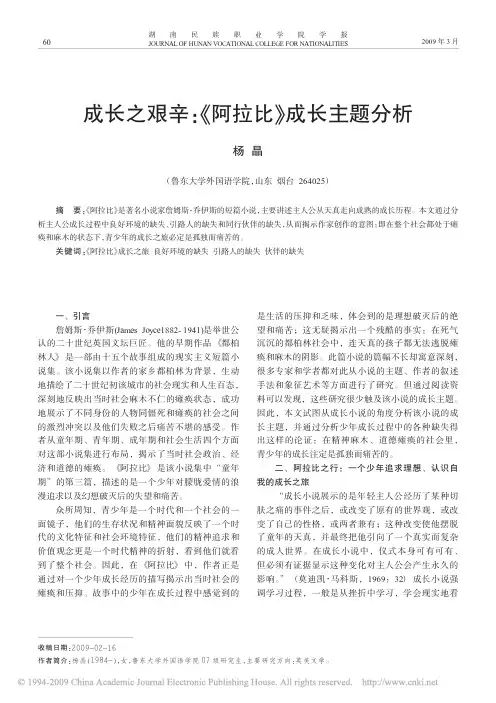
一、引言詹姆斯·乔伊斯(James Joyce1882-1941)是举世公认的二十世纪英国文坛巨匠。
他的早期作品《都柏林人》是一部由十五个故事组成的现实主义短篇小说集。
该小说集以作者的家乡都柏林为背景,生动地描绘了二十世纪初该城市的社会现实和人生百态,深刻地反映出当时社会麻木不仁的瘫痪状态,成功地展示了不同身份的人物同僵死和瘫痪的社会之间的激烈冲突以及他们失败之后痛苦不堪的感受。
作者从童年期、青年期、成年期和社会生活四个方面对这部小说集进行布局,揭示了当时社会政治、经济和道德的瘫痪。
《阿拉比》是该小说集中“童年期”的第三篇,描述的是一个少年对朦胧爱情的浪漫追求以及幻想破灭后的失望和痛苦。
众所周知,青少年是一个时代和一个社会的一面镜子,他们的生存状况和精神面貌反映了一个时代的文化特征和社会环境特征,他们的精神追求和价值观念更是一个时代精神的折射,看到他们就看到了整个社会。
因此,在《阿拉比》中,作者正是通过对一个少年成长经历的描写揭示出当时社会的瘫痪和压抑。
故事中的少年在成长过程中感觉到的是生活的压抑和乏味,体会到的是理想破灭后的绝望和痛苦;这无疑揭示出一个残酷的事实:在死气沉沉的都柏林社会中,连天真的孩子都无法逃脱瘫痪和麻木的阴影。
此篇小说的篇幅不长却寓意深刻,很多专家和学者都对此从小说的主题、作者的叙述手法和象征艺术等方面进行了研究。
但通过阅读资料可以发现,这些研究很少触及该小说的成长主题。
因此,本文试图从成长小说的角度分析该小说的成长主题,并通过分析少年成长过程中的各种缺失得出这样的论证:在精神麻木、道德瘫痪的社会里,青少年的成长注定是孤独而痛苦的。
二、阿拉比之行:一个少年追求理想、认识自我的成长之旅“成长小说展示的是年轻主人公经历了某种切肤之痛的事件之后,或改变了原有的世界观,或改变了自己的性格,或两者兼有;这种改变使他摆脱了童年的天真,并最终把他引向了一个真实而复杂的成人世界。
在成长小说中,仪式本身可有可有、但必须有证据显示这种变化对主人公会产生永久的影响。
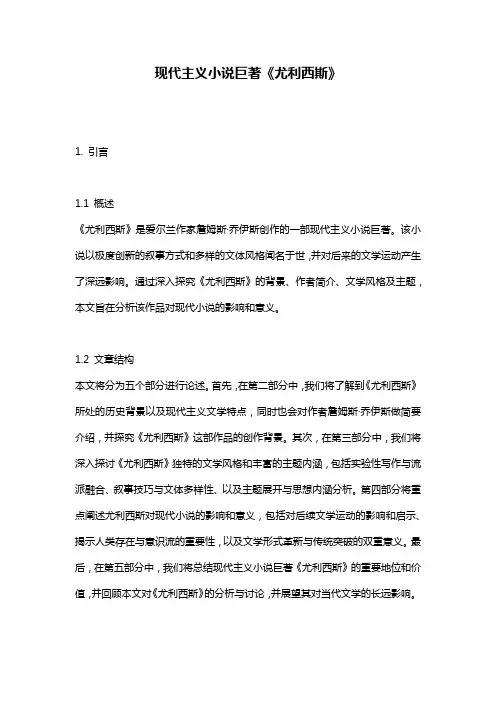
现代主义小说巨著《尤利西斯》1. 引言1.1 概述《尤利西斯》是爱尔兰作家詹姆斯·乔伊斯创作的一部现代主义小说巨著。
该小说以极度创新的叙事方式和多样的文体风格闻名于世,并对后来的文学运动产生了深远影响。
通过深入探究《尤利西斯》的背景、作者简介、文学风格及主题,本文旨在分析该作品对现代小说的影响和意义。
1.2 文章结构本文将分为五个部分进行论述。
首先,在第二部分中,我们将了解到《尤利西斯》所处的历史背景以及现代主义文学特点,同时也会对作者詹姆斯·乔伊斯做简要介绍,并探究《尤利西斯》这部作品的创作背景。
其次,在第三部分中,我们将深入探讨《尤利西斯》独特的文学风格和丰富的主题内涵,包括实验性写作与流派融合、叙事技巧与文体多样性、以及主题展开与思想内涵分析。
第四部分将重点阐述尤利西斯对现代小说的影响和意义,包括对后续文学运动的影响和启示、揭示人类存在与意识流的重要性,以及文学形式革新与传统突破的双重意义。
最后,在第五部分中,我们将总结现代主义小说巨著《尤利西斯》的重要地位和价值,并回顾本文对《尤利西斯》的分析与讨论,并展望其对当代文学的长远影响。
1.3 目的本文旨在全面分析现代主义小说巨著《尤利西斯》的各个方面,包括背景、作者简介、文学风格与主题,同时也探究该作品对现代小说的深远影响和意义。
通过深入研究,《尤利西斯》所蕴含的创新思想和艺术成就将会被呈现出来。
希望读者能够通过本文对《尤利西斯》有更加全面深入的了解,并认识到这部作品在现代文学史上所占据的重要地位。
2. 尤利西斯的背景与作者简介2.1 历史背景及现代主义文学特点在20世纪初,欧洲社会经历了巨大的变革和战争的冲击,这种不确定性和混乱导致了现代主义文学运动的兴起。
现代主义作品以独特的形式和内容挑战传统艺术观念,旨在捕捉当时复杂而多元化的现实。
2.2 作者詹姆斯·乔伊斯简介詹姆斯·乔伊斯(James Joyce, 1882-1941)是爱尔兰最知名和最有影响力的作家之一。
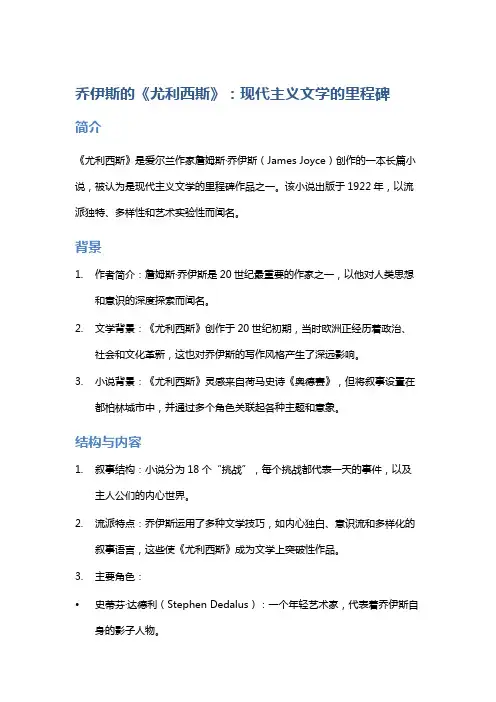
乔伊斯的《尤利西斯》:现代主义文学的里程碑简介《尤利西斯》是爱尔兰作家詹姆斯·乔伊斯(James Joyce)创作的一本长篇小说,被认为是现代主义文学的里程碑作品之一。
该小说出版于1922年,以流派独特、多样性和艺术实验性而闻名。
背景1.作者简介:詹姆斯·乔伊斯是20世纪最重要的作家之一,以他对人类思想和意识的深度探索而闻名。
2.文学背景:《尤利西斯》创作于20世纪初期,当时欧洲正经历着政治、社会和文化革新,这也对乔伊斯的写作风格产生了深远影响。
3.小说背景:《尤利西斯》灵感来自荷马史诗《奥德赛》,但将叙事设置在都柏林城市中,并通过多个角色关联起各种主题和意象。
结构与内容1.叙事结构:小说分为18个“挑战”,每个挑战都代表一天的事件,以及主人公们的内心世界。
2.流派特点:乔伊斯运用了多种文学技巧,如内心独白、意识流和多样化的叙事语言,这些使《尤利西斯》成为文学上突破性作品。
3.主要角色:•史蒂芬·达德利(Stephen Dedalus):一个年轻艺术家,代表着乔伊斯自身的影子人物。
•利奥波德·布鲁姆(Leopold Bloom):一个中年广告商,他经历了一系列奇妙而现实的冒险。
4.主题与意象:•人类存在与意义:小说对生命、爱情、性欲、宗教等议题进行深入探索。
•都柏林城市景观:都柏林作为背景地点,在小说中象征着城市生活的方方面面。
影响与评论1.文学影响:《尤利西斯》带来了现代主义文学的革新,对后来的作家产生了重大影响。
许多学者将其视为20世纪最重要的小说之一。
2.文化影响:该小说引发了广泛的文学评论和讨论,激发了人们对语言、意识和文化认同的思考。
3.评论观点:有些评论家称赞《尤利西斯》的创新性和深度,而另一些则批评其难以理解的叙事风格和复杂性。
结论作为现代主义文学的里程碑,《尤利西斯》在创作形式、主题选择和语言运用方面都有着重要地位。
它不仅是乔伊斯个人风格的体现,也成为了20世纪文学史上的经典之作。
James Joyce (1882-1941), Irish novelist, noted for his experimental use of language in such works as Ulysses (1922) and Finnegans Wake (1939). Joyce's technical innovations in the art of the novel include an extensive use of interior monologue; he used a complex network of symbolic parallels drawn from the mythology, history, and literature, and created a unique language of invented words, puns, and allusions.詹姆斯·奥古斯汀·艾洛依休斯·乔伊斯(James Augustine Aloysius Joyce),(1882年2月2曰——1941年1月13曰),爱尔兰作家和诗人,20世纪最重要的作家之一。
代表作包括短篇小说集《都柏林人》(1914)、长篇小说《一个青年艺术家的画像》(1916)、《尤利西斯》(1922)以及《芬尼根的苏醒》(1939)。
尽管乔伊斯一生大部分时光都远离故土爱尔兰,但早年在祖国的生活经历却对他的创作产生了深远的影响。
他的大部分作品都以爱尔兰为背景和主题。
他所创作的小说大多根植于他早年在都柏林的生活,包括他的家庭、朋友、敌人、中学和大学的岁月。
乔伊斯是用英文写作的现代主义作家中将国际化因素和乡土化情节结合最好的人。
James Joyce was born in Dublin, on February 2, 1882, as the son of John Stanislaus Joyce, an impoverished gentleman, who had failed in a distillery business and tried all kinds of professions, including politics and tax collecting. Joyce's mother, Mary Jane Murray, was ten years younger than her husband. She was an accomplished pianist, whose life was dominated by the Roman Catholic Church. In spite of their poverty, the family struggled to maintain a solid middle-class facade.乔伊斯出生于都柏林近郊拉斯加地区的一个富裕的天主教家庭。